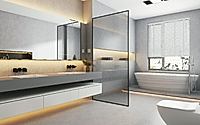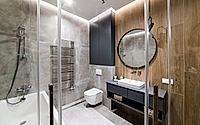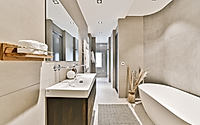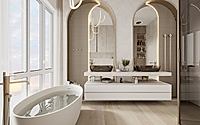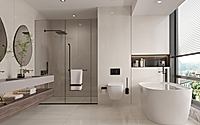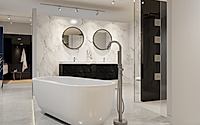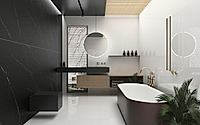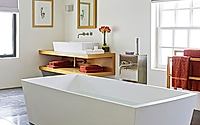Modern Bathtubs Continue To Trend in 2025
The bathroom has evolved from a purely functional space to a personal sanctuary, with bathtubs becoming the centerpiece of modern bathroom design. In 2025, innovative bathtub trends continue to reflect our changing lifestyles, technological advancements, and growing emphasis on wellness and sustainability. According to industry reports, the global bathtub market is projected to reach $13.4 billion by 2027, growing at a compound annual growth rate of 5.2% since 2022.
Wellness and Self-Care Focus
The pandemic-era emphasis on home wellness spaces has evolved into a permanent feature of modern bathroom design. Approximately 67% of recent bathroom renovations include upgraded bathtubs specifically designed for relaxation and therapeutic benefits. Chromotherapy tubs, which use colored lighting to enhance mood, have seen a 43% increase in sales since 2023.
Hydrotherapy continues to dominate the luxury segment, with advanced jet systems offering customizable massage experiences. The latest models feature smartphone integration, allowing users to control water temperature, jet intensity, and even ambient lighting through dedicated apps.
Sustainability Takes Center Stage
Eco-consciousness remains a driving force in bathtub design for 2025. Water conservation features are now standard in most mid-range to premium models, with smart bathtubs that precisely measure water usage gaining popularity. Studies show these smart systems can reduce water consumption by up to 30% compared to traditional bathtubs.
Material innovation has also aligned with sustainability goals. Recycled acrylic and biodegradable composites are increasingly common, with manufacturers highlighting their reduced carbon footprint. Several leading brands have introduced bathtubs made from up to 75% recycled materials while maintaining durability and aesthetic appeal in an effort to contribute to a more environmental-friendly vision.
Accessibility and Aging-in-Place Design
Universal design principles continue to influence bathtub trends, with manufacturers recognizing the diverse needs of users across age groups and abilities. Walk in bathtubs for seniors near the Sacramento area have seen particular growth, as the region’s retirement communities expand and aging homeowners prioritize modifications that allow them to remain in their homes longer.
These specialized tubs typically feature low thresholds, built-in seating, and safety grab bars, combining functionality with therapeutic benefits like hydrotherapy jets and heated surfaces. Local installation companies report a 38% increase in walk-in tub installations compared to the previous year, reflecting the region’s aging demographic and increased awareness of accessibility options.
Minimalist Aesthetics
The clean lines and understated elegance of minimalist design continue to dominate bathroom aesthetics in 2025. Freestanding bathtubs remain highly sought-after, with 59% of interior designers reporting them as the most requested bathtub style. The latest trend shows a preference for softer, organic shapes over the stark geometric forms that dominated previous years.
Matte finishes have overtaken glossy surfaces in popularity, with matte black, white, and neutral earth tones leading color preferences. Designers note that these subdued finishes better complement natural materials like wood and stone that are frequently paired with modern bathtubs.
Smart Technology Integration
Perhaps the most transformative trend in bathtub design is the integration of smart technology. Beyond basic features like temperature control and automatic filling, 2025’s smart bathtubs offer voice activation, personalized user profiles, and health monitoring capabilities.
Some premium models now include sensors that analyze water quality, adjust mineral content, and even monitor the user’s heart rate and body temperature during bathing. While these advanced models represent just 12% of current sales, industry analysts project this segment will grow by 28% annually over the next three years.
Mixed Materials and Textural Contrast
Designers are increasingly experimenting with material combinations to create visually interesting and tactile bathtub experiences. The juxtaposition of smooth acrylic with textured stone, wood accents, or metallic elements adds dimension and character to contemporary bathrooms.
Composite materials that mimic natural stone while offering improved heat retention and durability have gained significant market share, accounting for approximately 35% of premium bathtub sales. These materials provide the aesthetic appeal of natural stone without the maintenance requirements or weight concerns.
Final Word
As we progress through 2025, bathtub trends continue to reflect broader societal shifts toward wellness, sustainability, and technological integration. Whether homeowners are seeking accessibility solutions like walk-in tubs, eco-friendly materials, or smart features that enhance the bathing experience, manufacturers are responding with innovative designs that balance form and function.
The modern bathtub has transcended its utilitarian origins to become a statement piece that reflects personal values and lifestyle priorities. With the average American spending approximately 30 minutes daily in the bathroom, these trends suggest we’re increasingly viewing this time as an opportunity for self-care rather than merely necessity—transforming the humble bathtub into a cornerstone of home wellness design.
- by Matt Watts


